Executive Summary
Ally Financial Inc. (NYSE:ALLY) holds the position of being one of the largest auto lenders in the United States. The company has witnessed substantial growth over the past decade, primarily in prime auto loans. This expansion has resulted in an increase in its earning assets. The current environment, characterized by high-yield loans, has led to record-priced loan origination, with competitors exiting the market.
Notably, the company has made a strategic shift from high-cost corporate debt financing to a more cost-effective depositor-based financing approach. As the current loan portfolio turns over at high yields and depositor costs stabilize, it is anticipated that, assuming the Federal Reserve halts its rate increases, the Net Interest Margin (NIM) will rise.
Over the past decade, Ally Financial has undertaken share buybacks, effectively retiring 40% of its outstanding shares. Additionally, the company provides a 5% dividend to its shareholders. The stock’s target price is set at $75 per share, based on earnings of $6.00 per share at a price-to-earnings ratio of 12.5.
Background and History
Ally Financial Inc. traces its origins back to 1919 when it was established as an affiliate of General Motors (GM), operating under the name General Motors Acceptance Corporation or GMAC. Initially, its primary role was to serve as GM’s financial lending arm. However, over the years, the company expanded and diversified its operations beyond auto lending.
In 2006, GM made a significant move by selling a 51% stake of GMAC to Cerberus Capital Management. Subsequently, with the onset of the financial crisis in 2008, GMAC transformed into a bank holding company. During this turbulent period, several of the company’s non-auto lending ventures faced substantial challenges. Both its real estate division and subprime lending arm required intervention, with the U.S. Treasury stepping in to rescue or close these troubled divisions.
In an effort to rebrand and redefine itself, the company adopted the name Ally Bank in May 2009. Ally Financial continued to streamline its operations by divesting certain divisions. This process ultimately led to the company filing for an initial public offering (IPO), resulting in its transition to a publicly traded entity in April 2014.
Since becoming a publicly traded company, Ally Financial has experienced renewed growth, while still maintaining a significant focus on its core business of auto lending. In fact, more than 60% of its earnings assets continue to originate from car loans. The company headquarters is in Detroit, Michigan, and it maintains a substantial Corporate Center in Charlotte, North Carolina. With approximately 11,700 employees situated in offices throughout the United States, Ally Financial has a widespread presence.
Business Model
When Ally Financial became a publicly traded company in 2014, its primary business focus was on auto lending. At that time, the bank primarily relied on expensive corporate debt for its financing, which accounted for 60% of its total funding.
Over the past decade, Ally Financial has strategically worked to diversify and expand its funding sources. This effort has been highly successful, with retail deposits now constituting 80% of the bank’s funding, or as of the end of 2022, a total of $152 billion compared to earning assets of $188 billion. This shift away from expensive corporate debt financing has been a key part of the company’s financial strategy.
The foundation of Ally’s auto lending business was built on well-established relationships with original equipment manufacturers (OEMs) such as GM and Chrysler, as well as their network of franchised dealerships. The company also ventured into the used car market, leading to growth in financing volumes for used and leased vehicles.
Fast forwarding to the present day, Ally Financial has expanded its services to include a mortgage business and a consumer business. Within the consumer business, the company offers unsecured lending through point-of-sale financing and operates a credit card business.
As of the third quarter of 2023 (end of September 2023), here is the composition of Ally Financial’s earning assets:
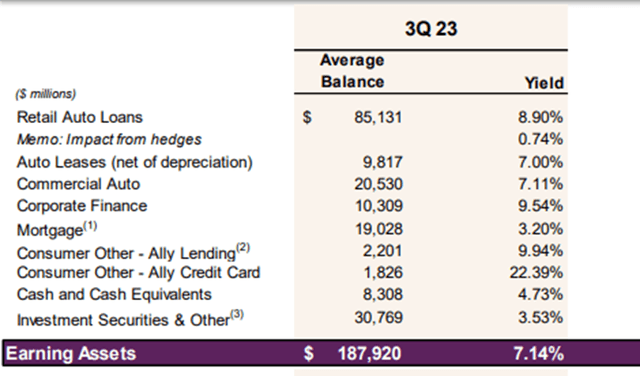
The different Earning Assets of Ally Financial (3Q23 Earnings Presentation)
As previously mentioned, Ally Financial has successfully transitioned its operations to being primarily funded by deposits from Ally Bank. Notably, Ally Bank is the largest online direct bank in the United States, which provides the company with a competitive advantage compared to traditional banks burdened by higher labor and physical location costs.
This shift to deposit funding comes with the trade-off of offering customers higher depositor fees compared to conventional banks. However, the company has leveraged this customer base for cross-selling opportunities, which ultimately enhances the yield on their offerings.
Ally Bank’s growth has been a remarkable success story, with its deposit base expanding from $53 billion at the end of 2013 to an impressive $153.5 billion as of the end of the third quarter in 2023. This growth continues to provide Ally Financial with a source of cost-effective and reliable financing, exemplified by a remarkable 96% retention rate in the last quarter. This stands in stark contrast to expensive and potentially challenging-to-refinance corporate debt.
The primary driver behind the decline in Net Interest Margin (NIM) and, consequently, lower net income has been the notable increase in the depositor charge. In the third quarter of 2023, NIM stood at 3.24%, down from 3.81% in the same quarter a year ago. Over the past year, the depositor fee has surged from 1.58% at the end of the third quarter in 2022 to a current rate of 4.04% as of the end of the third quarter in 2023, as detailed below.

Header (3Q23 Earnings Presentation)

Ally Financial’s funding structure (3Q23 Earnings Presentation )
However, Ally Bank possesses a significant strength in the stickiness of its customer base. With 3 million retail deposit customers, including an impressive 95,000 new customers in the last quarter, the bank boasts a remarkable 96% retention rate. Even during the recent regional banking crisis, the customer base continued to grow. As of the third quarter of 2023, retail deposits amounted to $140 billion, with 92% of balances being FDIC insured. In the graph provided, the $153.5 billion deposits figure encompasses a comprehensive range of deposits, including brokered deposits, sweep deposits, mortgage escrow deposits, and various other deposit types.
Furthermore, the higher interest rate environment has facilitated the underwriting business, allowing new loans to be priced at higher rates. The interest rate has steadily increased, reaching 7.1% in 2021, 8.2% in 2022, and an estimated 10.7% for the full year of 2023. This achievement has been accompanied by the origination of higher-quality loans and a lower approval rate, reflecting the company’s strong risk management practices.
In terms of loan underwriting, Ally primarily focuses on prime loans. Their underwriting business is heavily skewed towards S-tier (superprime) and A-tier (prime) loans, with minimal involvement in subprime (C/D/E Tier) underwriting, and has continued to move in that direction, as shown in the chart below.
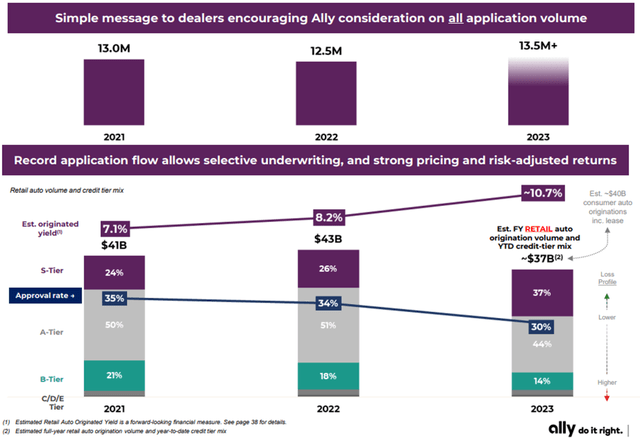
Ally Financial’s Book Turnover (3Q23 Earnings Presentation)
The challenge facing the company lies in the fact that not all of its assets on the balance sheet represent “new business.” Consequently, it takes some time for all their assets to be repriced in the current higher interest rate environment. Meanwhile, as the funding is now floating and based on deposits, the rate moves for the entire deposit base.
As car loans within the portfolio mature and turnover, the average yield is expected to increase. This concept carries substantial importance for future earnings growth in the coming quarters, and it’s a key consideration for investments in the company’s stock. The potential predicament hinges on the Federal Reserve’s decisions regarding interest rate hikes.
The company anticipates that, by actively managing its portfolio, it should be able to achieve a Net Interest Margin (NIM) that is 100 basis points higher within the next two years. This will be accomplished through a combination of allowing around 1/6 of the existing loans to be paid off and replacing them with new business at higher interest rates. Notably, the average car loan has a term of 72 months or 6 years, and there is approximately $40 billion or so of new business at these higher rates, as depicted in the illustrative slide below.
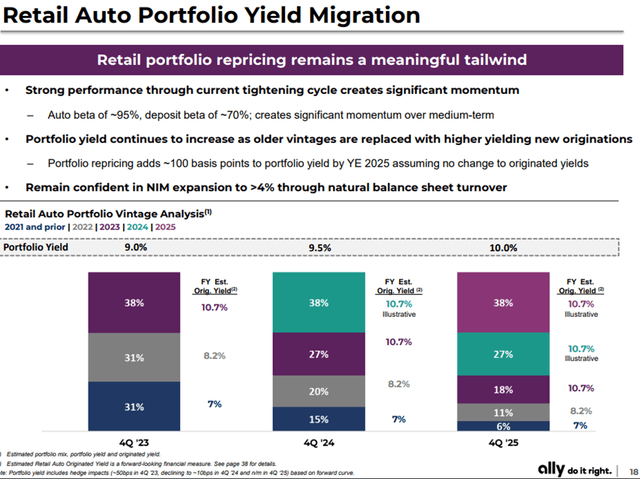
Retail Auto Portfolio Yield Migration (3Q23 Earnings Presentation)
To sum up the company’s business model, it revolves around underwriting high-quality loans collateralized mostly by auto vehicles while optimizing yield and minimizing funding costs to achieve a strong Net Interest Margin. Ally is also actively working to control non-interest expenses, having recently launched a cost-saving program with the goal of reducing costs by approximately $80 million. The current estimate for non-interest expenses is around $5 billion per year.
Ownership and Governance
As of June 30, 2023, Ally Financial has a total of 302 million shares outstanding. The largest shareholder is Berkshire Hathaway (BRK.A), led by the renowned investor Warren Buffett, who owns 29 million shares, equivalent to a 9.6% ownership stake. Warren Buffett’s affiliation with the company serves as a strong testament to Ally Financial’s investment potential. If you have the opportunity, attending Berkshire Hathaway’s annual shareholder meetings in Omaha is highly recommended.
The second-largest owner is the index fund Vanguard, holding 27.7 million shares, or 9.1% of the company. Following Vanguard is Harris Associates LP, the investment adviser to the Oakmark Funds, based in Chicago, which possesses 26 million shares, accounting for 8.1% ownership. BlackRock, the largest U.S. index fund, holds 18 million shares, representing a 6% ownership stake. Then the next owner is below 5% and account for 2.9% of the company.
Ally Financial’s CEO is Jeffrey J. Brown, who has held this position since 2015. Notably, he recently submitted his resignation but will continue to serve until January 31, 2024, or until a replacement is found. Brown’s new role will be as the President of Hendrick Automotive Group, a significant player in the automotive retail industry, boasting nearly 11,000 employees and 131 retail franchises across 13 states. It’s noteworthy that Hendrick Automotive Group is a long-time customer of Ally Financial. On a recent earnings call, Brown emphasized that his career move is not a result of any declining expectations within the industry or at Ally Financial.
Russell Hutchinson assumed the role of CFO in July 2023, taking over from interim CFO Bradley Brown. Hutchinson previously served as the COO for global mergers and acquisitions at Goldman Sachs Group, where he worked for two decades in the Investment Banking division, counting Ally Financial among his clients.
Ally Financial’s board of directors is composed of 12 members, with Franklin W. Hobbs serving as Chairman. As a bank holding company, Ally Financial operates under the scrutiny of regulatory bodies, subject to various requirements aimed at reducing risk and ensuring the stability of the institution.
Financial Performance
Since its IPO in 2014, Ally Financial has exhibited a consistent pattern of growth and improvement in its financial performance. The asset base has expanded from $151 billion to $188 billion, and Net Interest Income has increased from $2 billion to $6.1 billion at the end of 2022. Net income has shown improvement as well, climbing from $1.1 billion in 2014 to $1.7 billion at the end of 2022. This growth in earnings per share (EPS) has been further amplified by a substantial reduction in the company’s share count, increasing from $2.39 in 2014 to $5.70 by the close of 2022.
However, 2023 has seen some earnings pressure for Ally Financial, with the third quarter adjusted EPS at 83 cents, down from $1.12 in the same quarter in 2022. The two primary reasons for this recent earnings pressure are a lower Net Interest Margin (Revenue) and higher provision for credit losses. Net Interest Revenue for the third quarter of 2023 was $1,533 million, down from $1,719 million year-over-year. The provision for credit losses in non-interest expenses reached $508 million in the same quarter, compared to $438 million year-over-year. Total non-interest expenses were $1,231 million, up from $1,161 million year-over-year, primarily due to the higher provision for credit losses.
The increase in credit provisions reflects the company’s expectation of more defaults and a return to normal credit conditions from the exceptionally low delinquency rates observed during the COVID-19 pandemic. The annualized net charge-off rate (NCO) for the quarter stood at 1.85%, and the company anticipates a range of 2.2% to 2.4% for the next quarter, with a full-year expectation of 1.8%. While the year-over-year percentage change in the 30-day delinquency rate has shown an increase, it’s important to note that the prime delinquency rate (for borrowers with higher credit scores) is significantly lower than the subprime delinquency rate.
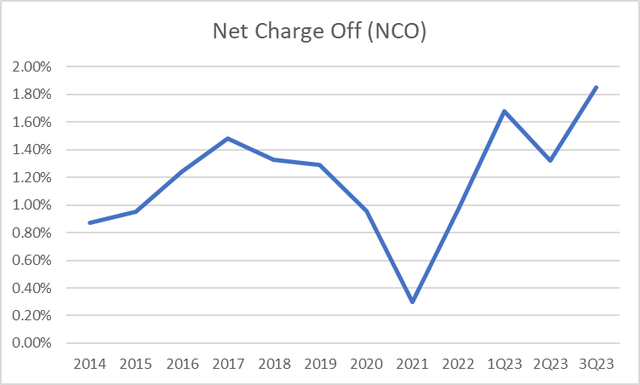
Ally Financial’s Net Charge Off history (10Ks)
Ally Financial’s Net Charge Off history (10Ks)
As Ally Financial faces some pressure in EPS, it continues to experience a strong flow of customers seeking its products, allowing for more selective underwriting. The company has lowered its approval rate to 30% from 35% in 2021, and this, along with a higher yield of 10.7% in 2023 compared to 7.1% in 2021, is expected to offset some of the earnings challenges.
The company’s underwriting volume is expected to be $37 billion for 2023, down from $43 billion in 2022 and $41 billion in 2021. This decline can be attributed to the company’s more selective underwriting practices. While the NCO rate has risen, it is important to consider that Ally Financial has a history of originating higher quality loans, which should help mitigate some of the credit concerns.
While there are reports of delinquency rates increasing, it’s worth noting that the most affected parties are independent lenders in the subprime space primarily for used-vehicle purchases. Ally Financial, on the other hand, has been adept at originating higher quality loans, which positions it more favorably in the current credit landscape. Nonetheless, keeping an eye on potential credit deterioration remains prudent, especially as the subprime delinquency rate is on the rise.
Ally Financial has demonstrated a remarkable improvement in its core return on tangible book/common equity (ROTCE) since its IPO, with consistent and steadily increasing returns. While the post-COVID years marked an exceptional period, the company has continued to maintain strong ROTCE figures, consistently surpassing the 12% mark in every quarter of 2023. This indicates the company’s ability to generate strong returns for its shareholders and underscores its financial stability and performance.
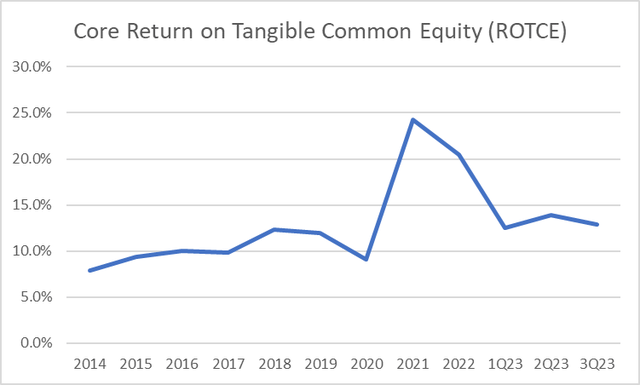
Ally Financial’s ROTCE history (10Ks)
Ally Financial’s
Common Equity Tier 1 (CET1) capital ratio is reported at a healthy 9.3%, surpassing the minimum regulatory requirement of 4.5%. The company’s target is to maintain a CET1 capital ratio above 9%, which is a good indicator of its strong capital position.
As of the last twelve months, Ally Financial has reported earnings per share (EPS) of $3.66. The current stock price is $24 per share, which results in a price-to-earnings (P/E) ratio of 6.5.
The tangible book value of the company is $10.5 billion, or $34.81 per share. This provides an indication of the company’s intrinsic value, considering its tangible assets and liabilities.
Balance Sheet Improvements and Share Buybacks
Ally Financial’s improvements in funding abilities and its credit rating underscore its progress and financial stability. The company’s journey in credit ratings is notable: it was rated Ba2 in 2019, upgraded to Ba1 that same year, and further improved to Baa3 in 2021, which represents the current Moody’s credit rating for the company’s long-term debt. This upward trajectory reflects a positive shift in the company’s creditworthiness and financial health.
One of the key factors in this transformation has been a substantial reduction in corporate debt as a portion of the company’s funding. While it accounted for 60% of the company’s funding in 2014 at the time of the IPO, it now stands at less than 20%. This strategic shift in funding sources has enabled the company to improve its Net Interest Margin (NIM), which was around 2.5% in the past and has risen to above 4% as recently as last year. Currently, NIM stands at 3.26%. In the prevailing higher interest rate environment, Ally Financial is well positioned to capitalize on its portfolio and achieve attractive lending yields, potentially leading to an increase in NIM.
The company’s improved balance sheet and profitability have also contributed to a reduction in its share count. Starting with approximately 480 million shares outstanding at the IPO, the company has managed to decrease the share count to the current level of 302 million shares. The share buyback program has recently slowed down, with no shares repurchased in 2023 so far. In January 2022, Ally Financial announced a $2 billion stock buyback program, of which the company executed $1.7 billion, equivalent to 42 million shares in 2022.
In addition to these financial improvements, Ally Financial has increased its dividend over the years. Since the beginning of 2022, the dividend has been set at 30 cents per quarter, which translates to approximately a 5% yield based on the current stock price of $24 per share. This ongoing dividend reflects the company’s commitment to returning value to its shareholders.
Industry Backdrop – growing industry with continued pressure from regulatory requirements
The U.S. auto lending industry comprises various types of lenders, including banks, captive financing companies associated with car manufacturers and dealerships, credit unions, finance firms, and specialized players like “buy here, pay here” businesses. Recent market dynamics show a few noteworthy trends:
Banks have seen a slight decline in market share, dropping from 31% in 2019 to 28% in 2022. This suggests changes in consumer preferences or perhaps some banks exiting the industry.
Captive financing companies, which are closely tied to car manufacturers and dealerships, have also experienced a reduction in market share, falling from 25% to 23%. This may reflect shifts in consumer relationships with auto manufacturers.
In contrast, credit unions have gained market share in both new and used auto financing. They appear to be offering competitive and attractive loan terms, attracting more borrowers to their services.
These market trends underscore the changing landscape of the auto lending industry and the ability of different types of lenders to adapt to shifting consumer preferences. In particular, credit unions have proven their ability to capture market share by providing appealing financing options for consumers
The total U.S. car loan market is substantial, with a size of $1.6 trillion, and it has displayed steady growth over the past decade. Even during the COVID-19 pandemic, the market saw a temporary dip from the first to the second quarter of 2020. The market’s size has continued to expand, growing by $80 billion in the second quarter of 2023. Notably, car loans account for approximately 9% of American consumer debt.
In the first quarter of 2023, the U.S. saw $159 billion in auto loan origination, translating to an annual origination of $636 billion. Ally Financial, with its approximately $40 billion in origination, holds a market share of around 6% in terms of new auto loan origination.
In the U.S. auto lending industry, the major players, ranked in the following order, are Toyota Financial Services, Ally Financial, GM Financial (GM), Chase Auto (JPM), and Capital One (COF). These institutions have different price-to-earnings ratios, with the two banks, Capital One trading at 7.7, and JP Morgan at 8.5.
Looking beyond the United States, the global auto loan market is expected to continue its growth trajectory, with some experts projecting it to reach $5.6 trillion by 2031, driven by an 11.5% compound annual growth rate (CAGR) from 2022 to 2031.
The competitive landscape in the auto lending industry is influenced by various factors, including regulatory pressures. Regulatory requirements, such as those stemming from Basel III, introduced after the global financial crisis of 2007/09, have imposed new liquidity and capital requirements. These requirements are phased in over time and have implications for how banks manage their capital and balance sheets. This has been a reason for some players, including Ally Financial, to adjust their financial strategies, including turning off share buyback programs.
Interestingly, these regulatory requirements have contributed to the shift in market share between banks, captive financing companies, and credit unions as banks are now required to hold more capital against their assets, which reduces their balance sheets and limits their leverage. This creates opportunities for those lenders who can adapt to the changing regulatory environment.
In addition to regulatory pressures, there have been recent challenges in the subprime loan market, with rising inflation and interest rates affecting the ability of less creditworthy borrowers to meet their obligations. Some subprime lenders, such as American Car Center, have faced financial difficulties, and credit rating agencies have put others, like Exeter Finance and United Auto Credit, under review for potential downgrades. As highlighted before, Ally Financial’s minimal subprime exposure positions it favorably in this context.
Value Proposition
Ally Financial has significantly strengthened its competitive position over the last decade, making it one of the largest U.S. bank auto lenders. This achievement is underscored by its increased origination and market share within the banking universe, while some banks have exited the auto lending market. Ally Financial’s transformation from relying on corporate debt to becoming an investment-grade issuer, primarily funded by retail depositors through Ally Bank, has not only lowered its funding costs but also provided more stable and “sticky” funding. This stability was evident during the recent regional banking crisis when Ally Bank attracted depositors.
The company’s strategic focus is on better-quality customers while still growing its earning assets positions it well for future success. The reduction in the share count enhances the potential for share price appreciation when interest rates normalize and earnings stabilize.
As highlighted in this report, the company’s prospects include reaching a higher Net Interest Margin by the end of 2024 or beginning of 2025, based on repricing its portfolio at higher yields. This shift could lead to earnings of $6 per share. With assumptions of a 50-75 basis point improvement in NIM within 1.5 years and a higher price-to-earnings ratio of 12.5, which is historically fair for a growing financial stock, there is potential for significant share price growth. The target price set at $75 per share reflects the expectation of a meaningful re-rating of the stock.
In the meantime, shareholders can benefit from a 5% dividend yield, providing income while they await the expected re-rating of the stock and future share price appreciation. These factors combined make Ally Financial an interesting prospect for investors.
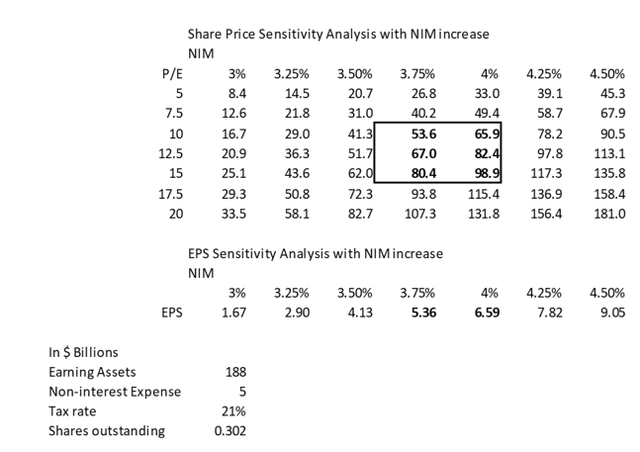
Ally Financial’s Share Price Potential (Robin Capital Group Model)
Catalysts
The outlook for Ally Financial suggests that an earnings inflection point is approaching, likely a few quarters away. This expected inflection is driven by several factors:
Higher Reserves: The company has increased its reserves, which temporarily impacts earnings. As economic conditions stabilize, these reserves can potentially be released, positively affecting future earnings.
Higher Depositor Rates: The increase in depositor rates, while impacting net interest margin in the short term, provides an incentive for retail depositors to stay with Ally Bank. This stable and growing retail deposit base is a source of lower-cost and more stable funding.
Portfolio Turnover: As the portfolio of loans turns over at higher yields, this will contribute to an increase in the Net Interest Margin (NIM).
Basel III Compliance: Clarity on Basel III capital and liquidity requirements will enable the company to better plan its capital allocation, including the possibility of resuming share buybacks.
The alignment of these factors suggests that Ally Financial is on the cusp of a positive earnings trajectory. By managing its capital and portfolio effectively and maintaining its focus on prudent lending practices, the company is positioned to capture opportunities as the market conditions evolve. The inflection point in earnings, coupled with clarity on regulatory requirements, can be a catalyst for future stock re-rating.
Risks
The macroeconomic risks outlined pose challenges for Ally Financial and the broader auto lending industry. These risks include:
Slowing Demand for Autos: An increase in the federal funds rate can lead to higher borrowing costs for consumers, potentially reducing demand for auto loans. Economic recessions or downturns can also result in consumers defaulting on car loans, affecting the performance of the loan portfolio. Slowing demand and loan defaults can put pressure on the company’s revenue and profitability.
Credit Score Degradation and Net Charge-Offs: If economic conditions worsen, even prime customers may experience credit score degradation, leading to a rise in net charge-offs. This could impact the quality of the loan portfolio and necessitate additional provisions for loan losses.
Continued Rate Hikes by the Federal Reserve: If the Federal Reserve continues to raise interest rates, it can increase funding costs for banks, including Ally Bank. This may affect the bank’s net interest margin, potentially requiring adjustments in deposit rates to remain competitive.
Regulatory Capital and Liquidity Requirements: Regulatory requirements, such as Basel III, have introduced new capital and liquidity standards for banks. These requirements can be stringent and influence how banks manage their capital and balance sheets. They may limit the leverage that banks can use and have financial implications for the institutions.
To address these challenges, Ally Financial must implement effective risk management strategies, including prudent lending practices, careful underwriting, and the building of loan loss reserves. The company should also maintain a strong capital position to absorb potential losses during economic downturns. Adjustments to depositor rates may be necessary to manage funding costs while retaining and attracting customers.
It is important for Ally Financial to remain vigilant, adapt to changing market conditions, and continue to monitor economic and regulatory developments. Effective risk management, capital allocation, and prudent decision-making are essential for navigating the macroeconomic risks you’ve highlighted.
Conclusion
In summary, Ally Financial presents a promising risk-reward opportunity, with the potential for higher earnings in the near future. Several factors support this outlook:
Earnings Upside: If you believe that the Federal Reserve is nearing the end of its rate-hiking cycle, Ally Financial’s earnings could benefit significantly as its loan portfolio turns over in a high-yield environment and deposit rates remain relatively stable.
Credit Loss Provision: The increase in the provision for credit losses can largely be attributed to credit normalization following the post-COVID-19 bailout period. Ally Financial’s borrowers primarily consist of super prime and prime customers, which mitigates the credit risk.
Operating Leverage: The company’s earnings demonstrate significant operating leverage, where even small changes in the net interest margin have a substantial impact on earnings. This characteristic works both to the downside and the upside, potentially boosting profitability.
Market Position: Ally Financial’s position as the largest auto lender, focusing on super prime and prime borrowers, strengthens its competitive advantage. This is particularly valuable as more banks exit the auto lending space, and subprime lenders face challenges.
Valuation: The stock is currently trading at a low multiple and well below book value, making it an attractive proposition. When earnings start to increase, the stock may experience a significant re-rating.
The company has solidified its position in the industry over the past decade and is well-prepared to weather challenging economic environments. Ally Financial’s strategic focus on quality borrowers and the reduction in subprime exposure position it well for future success. As other financial institutions exit the auto lending space, Ally Financial’s market share may continue to grow, further enhancing its competitive moat.
Investors considering Ally Financial should keep an eye on the macroeconomic environment, particularly Federal Reserve policy and regulatory developments. These factors will play a crucial role in shaping the company’s future performance and investment potential.
Read the full article here



